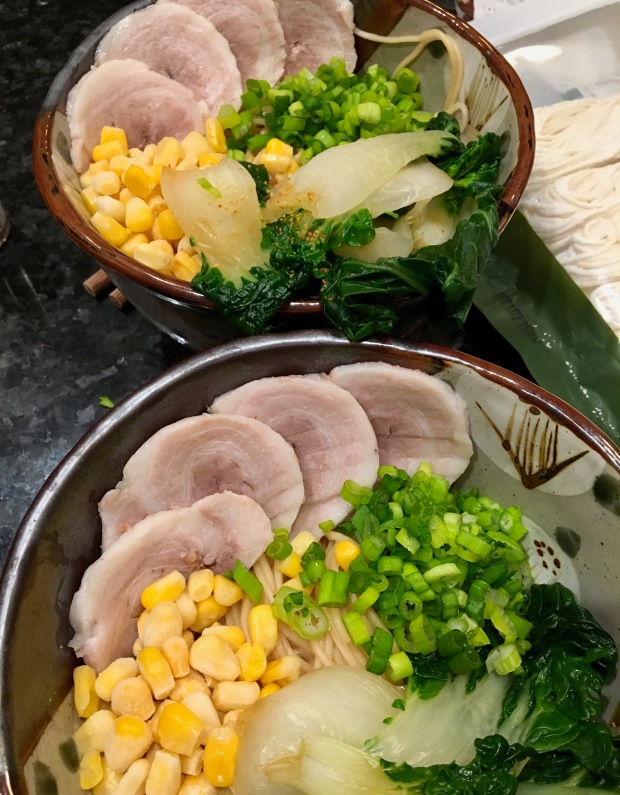
Pasta with Ragù (Meat Sauce)
Ingredients
- 5 garlic cloves (peeled and chopped)
- 1 small onion (peeled and chopped)
- 2 Tbsps olive oil
- 900 g ground meat (beef, pork, elk, bison, turkey or chicken)
- 1/2 cup red wine
- 150 ml tomato paste (5.5 oz)
- 800 ml canned tomatoes (27 oz)
- 1/2 cup beef broth
- 1/2 cup whole milk
- 1 cup grated parmesan cheese
- 1 dash ground nutmeg
- 1 dash dried oregano
- 4 cups dried pasta
- 1/2 cup reserved pasta water
- salt and white pepper (to taste)
Instructions
- Add the olive oil to a large heavy-bottomed pot and heat on medium high. Add onion and garlic, sautéing until onions have softened and garlic is fragrant. Add the meat to the pot, and sauté, breaking the meat apart as it cooks. Add wine, cook until the liquid is gone. Add tomato paste and stir, mixing completely. Add the dash of oregano and nutmeg. Add beef broth, milk, and tomatoes and stir well. Turn the heat down to medium and cook for about 30 minutes, or until the sauce has thickened. Add the parmesan cheese, stirring in until fully melted. Cook pasta in a pot of boiling water. Reserve 1/2 cup of the pasta water and add to the sauce, allow it to cook down further. Drain pasta. Mix the pasta with the sauce. Serve.
And now for the details…
Hi-yo folks! Here we are in day 6 of 14; almost halfway through quarantine and still making use of our generous friend’s grocery drop-off from last Monday, as well as our, thankfully, well-stocked freezer and pantry. We are starting to run low on fresh produce, though, now that almost a week has gone by. Luckily for us, another couple friends of ours have already stepped up and offered to go out tomorrow to top us up for the rest of our isolation period! We are feeling incredibly blessed by the support team we have at home, whether it’s in surprise gift drop-offs on our doorstep (we got fresh bread and cheese dropped by a friend this weekend, and a gag gift from other friends of a Kraft pizza kit), the full-on grocery deliveries, or the regular check-ins via phone or social media (or even on this blog! Lookin’ at you auntie ;D), we have been so lucky to have such a kickass group of family and friends. Now for a small ask: if you know of someone who is lacking this support network and needs some help during these times, reach out (but don’t touch!) to see if you can help in any way. Maybe it’s picking up a few extra groceries when you are buying your own, providing a social connection (while maintaining physical distance!), or running an errand that they cannot do themselves. We’re all on Team People, let’s take care of each other.
Let’s get to cooking.
We start by chopping the onion and garlic. Heat a large pot to medium-high, and add the olive oil, then add the onion and garlic and cook, stirring regularly, until the onion is soft and the garlic is fragrant.

Next, you will add the meat to the pot. For this recipe, I had both ground beef and ground elk in the freezer. But you could use any mix and match of ground meat for your recipe, depending on your taste preferences, or what you have available. As the meat cooks, break it apart with a wooden spoon, so you end up with small pieces of meat. Once the meat has mostly cooked, add the red wine, and allow it to cook down until the liquid is almost completely gone.

Add the tomato paste, and just a dash of nutmeg and oregano (a small pinch of each). Stir to mix completely, cooking for about five minutes, allowing any liquid to be cooked off. Add the beef broth and tomatoes, and stir together. Then add the milk and stir completely.

Reduce the heat down medium, and allow the sauce to cook down, stirring occasionally to prevent any stickage (that’s a word, right?) to the bottom of the pot. Cook the sauce for around 20-30 minutes, or until the sauce has become very thick.

Cook the pasta in heavily salted water until al dente. For the batch that I made, I used Mafalda Corta, which is kinda like smaller lasagna noodles that have been cut into pieces. Feel free to use whatever pasta you have available. Fusilli, rigatoni, farfalle, pappardelle, you choose! The biggest thing to remember: save about 1/2 cup of the pasta water after it is done cooking, and add it to the sauce before you drain the pasta. This addition of starch from the water will help to thicken the sauce further as you cook it down, and will allow the sauce to better stick to your noodles.
Fun fact that has worked well for me since I discovered it: keep a wooden spoon in the pasta and water as it cooks to help prevent the water from boiling over.

Reduce the pasta sauce back down after the addition of pasta water and add the parmesan cheese. Salt and pepper the sauce to your taste. Avoid adding salt before this, as both the pasta water and the parmesan will add a certain amount of saltiness, and you may not want to add any more.
Finally, once everything has cooked and the pasta is drained, mixed the pasta and sauce together, and serve, maybe with a bit of additional parmesan on top.

Happy eating.
























































